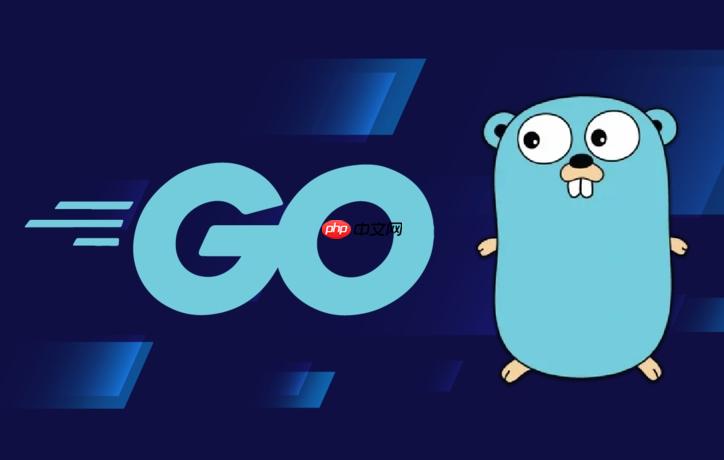golang单元测试是用代码验证代码是否按预期工作,以发现bug、提高质量并支持重构。其核心解决方案依赖标准库testing,流程包括:1.创建以\_test.go结尾的测试文件;2.编写以test开头、含*testing.t参数的测试函数;3.使用t.errorf等方法进行断言;4.运行go test命令执行测试。为提升可维护性,应采用清晰命名、覆盖边界条件、减少重复代码、使用表驱动测试。对于外部依赖,可通过gomock框架定义接口、生成mock对象、设置预期行为并注入测试代码中。并发测试可用sync.waitgroup、chan及t.parallel()实现并行控制。benchmark测试以benchmark开头,用*testing.b参数评估性能,通过go test -bench=.运行。代码覆盖率工具go test -coverprofile及go tool cover可分析测试覆盖情况,但覆盖率仅作参考指标。

Golang单元测试,简单来说,就是用代码来验证你的代码是否按照预期工作。它能帮你尽早发现bug,提高代码质量,并让你更有信心进行重构。

Golang的单元测试非常方便,标准库testing已经提供了所有你需要的基础设施。一个基本的测试流程如下:

my_module.go文件,创建一个对应的my_module_test.go文件。Test开头,并且接收一个*testing.T类型的参数。t.Errorf、t.Fatalf等方法来报告测试失败。go test命令运行测试。下面是一个简单的例子:
立即学习“go语言免费学习笔记(深入)”;
// my_module.go
package mymodule
func Add(a, b int) int {
return a + b
}
// my_module_test.go
package mymodule
import "testing"
func TestAdd(t *testing.T) {
result := Add(2, 3)
if result != 5 {
t.Errorf("Add(2, 3) = %d; want 5", result)
}
}运行 go test,如果一切正常,你会看到 "PASS"。

编写可维护的单元测试,意味着你的测试不仅要能发现bug,还要易于理解、修改和扩展。可以试试以下几个技巧:
TestAdd_PositiveNumbers 比 TestAdd 更好。下面是一个表驱动测试的例子:
func TestAdd(t *testing.T) {
testCases := []struct {
a, b int
expected int
}{
{2, 3, 5},
{-1, 1, 0},
{0, 0, 0},
{10, -5, 5},
}
for _, tc := range testCases {
result := Add(tc.a, tc.b)
if result != tc.expected {
t.Errorf("Add(%d, %d) = %d; want %d", tc.a, tc.b, result, tc.expected)
}
}
}在单元测试中,我们希望隔离被测试的代码,避免受到外部依赖的影响。这时,就需要使用 Mock。Golang有很多Mock框架,例如gomock。
使用 gomock 的基本步骤:
gomock 生成接口的 Mock 对象。EXPECT() 方法设置 Mock 对象的预期行为和返回值。例如,假设你的代码依赖于一个数据库连接:
// db.go
package db
type Database interface {
Get(key string) (string, error)
}
// my_module.go
package mymodule
import "db"
type MyService struct {
db db.Database
}
func (s *MyService) GetData(key string) (string, error) {
return s.db.Get(key)
}你可以这样 Mock 数据库连接:
// my_module_test.go
package mymodule
import (
"testing"
"db"
"github.com/golang/mock/gomock"
)
//go:generate mockgen -destination=mock_db.go -package=mymodule db Database
func TestGetData(t *testing.T) {
ctrl := gomock.NewController(t)
defer ctrl.Finish()
mockDB := NewMockDatabase(ctrl)
mockDB.EXPECT().Get("mykey").Return("myvalue", nil)
service := &MyService{db: mockDB}
result, err := service.GetData("mykey")
if err != nil {
t.Fatalf("unexpected error: %v", err)
}
if result != "myvalue" {
t.Errorf("GetData() = %v, want myvalue", result)
}
}首先,需要安装 gomock: go install github.com/golang/mock/mockgen@v1.6.0。 然后,使用 go generate 命令生成 Mock 对象:go generate。
测试并发代码是一项挑战,因为它涉及到不确定性和竞态条件。Golang提供了一些工具来帮助你测试并发代码:
sync.WaitGroup: 用于等待一组 Goroutine 完成。chan: 用于 Goroutine 之间的通信。testing.T.Parallel(): 允许并行运行测试用例。一个简单的例子:
func TestParallel(t *testing.T) {
testCases := []int{1, 2, 3, 4, 5}
for _, tc := range testCases {
tc := tc // Capture range variable
t.Run(fmt.Sprintf("TestCase-%d", tc), func(t *testing.T) {
t.Parallel() // Mark this test case as parallel
// Simulate some work
time.Sleep(time.Duration(tc) * time.Millisecond)
fmt.Printf("Running test case: %d\n", tc)
// Add your assertions here
})
}
}注意,t.Parallel() 必须在每个并行运行的测试用例中调用。 另外,要小心共享变量,使用互斥锁或其他同步机制来避免竞态条件。
Benchmark测试用于评估代码的性能。Golang的testing包也提供了Benchmark测试的支持。
Benchmark测试函数必须以Benchmark开头,并且接收一个*testing.B类型的参数。
func BenchmarkAdd(b *testing.B) {
for i := 0; i < b.N; i++ {
Add(2, 3)
}
}运行Benchmark测试:go test -bench=.。 -bench=. 表示运行所有Benchmark测试。
Benchmark测试会运行多次,并报告每次操作的平均时间。
代码覆盖率工具可以帮助你了解你的测试覆盖了多少代码。Golang提供了一个内置的代码覆盖率工具。
运行代码覆盖率:go test -coverprofile=coverage.out。
然后,可以使用go tool cover命令来分析覆盖率结果:
go tool cover -html=coverage.out:生成一个HTML报告,显示哪些代码被覆盖了,哪些代码没有被覆盖。go tool cover -func=coverage.out:显示每个函数的覆盖率。代码覆盖率只是一个指标,不能完全保证代码的质量。但是,它可以帮助你发现测试的盲点,并提高代码的可靠性。
以上就是Golang单元测试怎么写?Golang单元测试最佳实践的详细内容,更多请关注php中文网其它相关文章!

每个人都需要一台速度更快、更稳定的 PC。随着时间的推移,垃圾文件、旧注册表数据和不必要的后台进程会占用资源并降低性能。幸运的是,许多工具可以让 Windows 保持平稳运行。

Copyright 2014-2025 https://www.php.cn/ All Rights Reserved | php.cn | 湘ICP备2023035733号